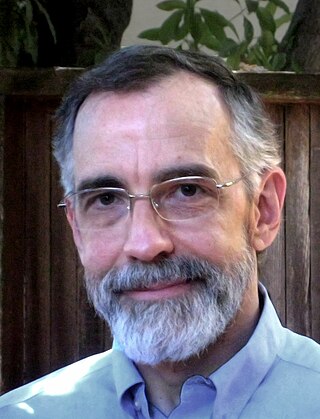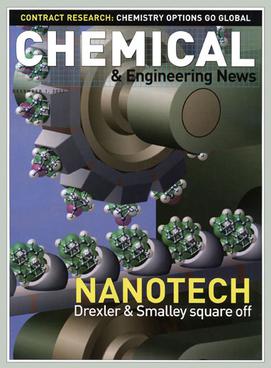
Kim Eric Drexler is an American engineer best known for introducing molecular nanotechnology (MNT), and his studies of its potential from the 1970s and 1980s. His 1991 doctoral thesis at Massachusetts Institute of Technology was revised and published as the book Nanosystems: Molecular Machinery Manufacturing and Computation (1992), which received the Association of American Publishers award for Best Computer Science Book of 1992. He has been called the "godfather of nanotechnology".

Molecular nanotechnology (MNT) is a technology based on the ability to build structures to complex, atomic specifications by means of mechanosynthesis. This is distinct from nanoscale materials. Based on Richard Feynman's vision of miniature factories using nanomachines to build complex products, this advanced form of nanotechnology would make use of positionally-controlled mechanosynthesis guided by molecular machine systems. MNT would involve combining physical principles demonstrated by biophysics, chemistry, other nanotechnologies, and the molecular machinery of life with the systems engineering principles found in modern macroscale factories.

Nanotechnology was defined by the National Nanotechnology Initiative as the manipulation of matter with at least one dimension sized from 1 to 100 nanometers (nm). At this scale, commonly known as the nanoscale, surface area and quantum mechanical effects become important in describing properties of matter. The definition of nanotechnology is inclusive of all types of research and technologies that deal with these special properties. It is therefore common to see the plural form "nanotechnologies" as well as "nanoscale technologies" to refer to the broad range of research and applications whose common trait is size. An earlier description of nanotechnology referred to the particular technological goal of precisely manipulating atoms and molecules for fabrication of macroscale products, also now referred to as molecular nanotechnology.

"There's Plenty of Room at the Bottom: An Invitation to Enter a New Field of Physics" was a lecture given by physicist Richard Feynman at the annual American Physical Society meeting at Caltech on December 29, 1959. Feynman considered the possibility of direct manipulation of individual atoms as a more robust form of synthetic chemistry than those used at the time. Although versions of the talk were reprinted in a few popular magazines, it went largely unnoticed until the 1980s.

Richard Errett Smalley was an American chemist who was the Gene and Norman Hackerman Professor of Chemistry, Physics, and Astronomy at Rice University. In 1996, along with Robert Curl, also a professor of chemistry at Rice, and Harold Kroto, a professor at the University of Sussex, he was awarded the Nobel Prize in Chemistry for the discovery of a new form of carbon, buckminsterfullerene, also known as buckyballs. He was an advocate of nanotechnology and its applications.
Gray goo is a hypothetical global catastrophic scenario involving molecular nanotechnology in which out-of-control self-replicating machines consume all biomass on Earth while building many more of themselves, a scenario that has been called ecophagy(the literal consumption of the ecosystem). The original idea assumed machines were designed to have this capability, while popularizations have assumed that machines might somehow gain this capability by accident.
Exploratory engineering is a term coined by K. Eric Drexler to describe the process of designing and analyzing detailed hypothetical models of systems that are not feasible with current technologies or methods, but do seem to be clearly within the bounds of what science considers to be possible within the narrowly defined scope of operation of the hypothetical system model. It usually results in paper or video prototypes, or computer simulations that are as convincing as possible to those that know the relevant science, given the lack of experimental confirmation. By analogy with protoscience, it might be considered a form of protoengineering.

A molecular assembler, as defined by K. Eric Drexler, is a "proposed device able to guide chemical reactions by positioning reactive molecules with atomic precision". A molecular assembler is a kind of molecular machine. Some biological molecules such as ribosomes fit this definition. This is because they receive instructions from messenger RNA and then assemble specific sequences of amino acids to construct protein molecules. However, the term "molecular assembler" usually refers to theoretical human-made devices.
Mechanosynthesis is a term for hypothetical chemical syntheses in which reaction outcomes are determined by the use of mechanical constraints to direct reactive molecules to specific molecular sites. There are presently no non-biological chemical syntheses which achieve this aim. Some atomic placement has been achieved with scanning tunnelling microscopes.

A self-replicating machine is a type of autonomous robot that is capable of reproducing itself autonomously using raw materials found in the environment, thus exhibiting self-replication in a way analogous to that found in nature. The concept of self-replicating machines has been advanced and examined by Homer Jacobson, Edward F. Moore, Freeman Dyson, John von Neumann, Konrad Zuse and in more recent times by K. Eric Drexler in his book on nanotechnology, Engines of Creation and by Robert Freitas and Ralph Merkle in their review Kinematic Self-Replicating Machines which provided the first comprehensive analysis of the entire replicator design space. The future development of such technology is an integral part of several plans involving the mining of moons and asteroid belts for ore and other materials, the creation of lunar factories, and even the construction of solar power satellites in space. The von Neumann probe is one theoretical example of such a machine. Von Neumann also worked on what he called the universal constructor, a self-replicating machine that would be able to evolve and which he formalized in a cellular automata environment. Notably, Von Neumann's Self-Reproducing Automata scheme posited that open-ended evolution requires inherited information to be copied and passed to offspring separately from the self-replicating machine, an insight that preceded the discovery of the structure of the DNA molecule by Watson and Crick and how it is separately translated and replicated in the cell.
Post-scarcity is a theoretical economic situation in which most goods can be produced in great abundance with minimal human labor needed, so that they become available to all very cheaply or even freely.

The nanocar is a molecule designed in 2005 at Rice University by a group headed by Professor James Tour. Despite the name, the original nanocar does not contain a molecular motor, hence, it is not really a car. Rather, it was designed to answer the question of how fullerenes move about on metal surfaces; specifically, whether they roll or slide.
Emerging technologies are technologies whose development, practical applications, or both are still largely unrealized. These technologies are generally new but also include older technologies finding new applications. Emerging technologies are often perceived as capable of changing the status quo.
The history of nanotechnology traces the development of the concepts and experimental work falling under the broad category of nanotechnology. Although nanotechnology is a relatively recent development in scientific research, the development of its central concepts happened over a longer period of time. The emergence of nanotechnology in the 1980s was caused by the convergence of experimental advances such as the invention of the scanning tunneling microscope in 1981 and the discovery of fullerenes in 1985, with the elucidation and popularization of a conceptual framework for the goals of nanotechnology beginning with the 1986 publication of the book Engines of Creation. The field was subject to growing public awareness and controversy in the early 2000s, with prominent debates about both its potential implications as well as the feasibility of the applications envisioned by advocates of molecular nanotechnology, and with governments moving to promote and fund research into nanotechnology. The early 2000s also saw the beginnings of commercial applications of nanotechnology, although these were limited to bulk applications of nanomaterials rather than the transformative applications envisioned by the field.

Lev Andreevich Navrozov was a Russian author, historian and polemicist, born in Moscow and father of poet Andrei Navrozov. A leading translator of Russian texts into English under the Soviet regime, Navrozov emigrated to the United States in 1972, where he published a best-selling memoir, The Education of Lev Navrozov, and became a prominent Russian dissident.
The following outline is provided as an overview of and topical guide to nanotechnology:
Wet nanotechnology involves working up to large masses from small ones.

The Drexler–Smalley debate on molecular nanotechnology was a public dispute between K. Eric Drexler, the originator of the conceptual basis of molecular nanotechnology, and Richard Smalley, a recipient of the 1996 Nobel prize in Chemistry for the discovery of the nanomaterial buckminsterfullerene. The dispute was about the feasibility of constructing molecular assemblers, which are molecular machines which could robotically assemble molecular materials and devices by manipulating individual atoms or molecules. The concept of molecular assemblers was central to Drexler's conception of molecular nanotechnology, but Smalley argued that fundamental physical principles would prevent them from ever being possible. The two also traded accusations that the other's conception of nanotechnology was harmful to public perception of the field and threatened continued public support for nanotechnology research.
This glossary of nanotechnology is a list of definitions of terms and concepts relevant to nanotechnology, its sub-disciplines, and related fields.
Ethics of nanotechnology is the study of the ethical issues emerging from advances in nanotechnology and its impacts.










